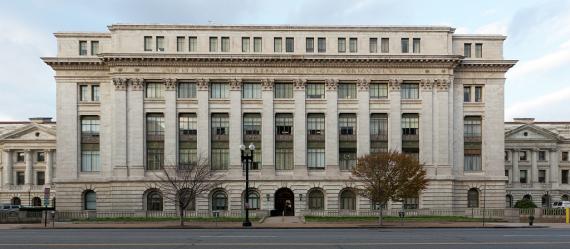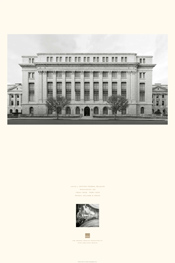Location: 12th St. and Jefferson Dr., SW, Washington, DC, 20024
History
Through the latter half of the nineteenth century, the U.S. Department of Agriculture established its physical presence on the western end of the Mall in Washington, D.C., with a collection of Victorian-era brick and wood buildings, grouped in an informal plan. By the turn of the century, the department had out-grown its existing facilities and sought a Congressional appropriation to build a combined laboratory and administrative building. This new Administration Building would begin the transformation of the department’s complex into a highly formal composition of classical style buildings and would set the standard for the large federal buildings of the early part of the twentieth century.
The design and siting of the new Administration Building was subject to direct influence of McMillan Plan architects Charles McKim and Daniel Burnam, who advised President Theodore Roosevelt on the implementation of the plan during its early years. The 1901 McMillan Plan sought to reconcile competing visions of the development of the federal city, and featured a landscaped and harmonious Mall, its central core free of buildings. The original site for the new building intruded into the Mall. The site was twice moved to conform to the plan’s set back and axial alignment requirements, ultimately resulting in alterations to the design. Thus, the Administration Building was the first building constructed on Mall in accordance with the building
lines established by the McMillan Plan.
Bounded by Jefferson Drive, Independence Avenue, Twelfth Street, and Fourteenth Street, Southwest, the building was designed by the Philadelphia firm of Rankin, Kellogg and Crane. The original appropriation allowed for the construction of the two L-shaped laboratory wings, erected between 1904 and 1908. A subsequent appropriation provided for the construction of
the central block, between 1928 and 1930. The building has served as the office of every secretary of Agriculture since 1930. In 1974, it was listed in the National Register of Historic Places. In 1995, the building was named for Congressman Jamie L. Whitten of Mississippi who served as chairman of the Agriculture Appropriations Subcommittee. The only departmental office building on the National Mall, it exemplifies the importance of the Department of Agriculture at the time it was built.
Architecture
The architect’s original plan called for the central domed administrative building with two large U-shaped laboratory wings, one on either side. Although never completed as proposed due to the lengthy hiatus in construction phases, the original design served as the basis for the design of the completed building, which exhibits the Beaux Arts Classicism favored by the McMillan Commission. Major elements, including the dome and the height and configuration of the wings, were changed due to the reduced size of the site, reduced appropriations, and direction from the architects of the former McMillan Commission and later from the U.S. Commission of Fine Arts.
The facade of the long, white marble building is composed of three major elements: the taller, five story, projecting central block and the two flanking, symmetrical, four-story wings. The three elements are joined together by two recessed, symmetrical, three-story, connecting corridor links, dating to 1930. The overall shape is that of an elongated E with the primary facade facing the Mall and the L-shaped wings returning toward Independence Avenue.
The central block is five stories in height, the top story being an attic above the entablature. The principal element is a shallow Roman Corinthian portico which rises from the top of the rusticated ground floor through the fourth floor. A series of arched openings pierce the rusticated base. The entablature of the central block has a modillioned cornice and supports a paneled parapet above the portico. The three attic panels carry quotations from Saint Paul, Abraham Lincoln, and George Washington referring to agriculture. The main entryway is at grade through the three central arches in the rusticated ground floor.
The wings are four stories with a rusticated ground floor, a piano nobile, a third floor and an attic floor set behind the balustrades capping the entablature. Three-bay pavilions project slightly at each end of the two wings. The pavilions have engaged Roman Ionic colossal orders above the rusticated base and pediments containing allegorical sculptures symbolizing fruits, flowers, cereals, and forests. All ground floor windows are round arched. The main floor windows have flat caps, and those above have simple architraves. The wings have denticulated cornices and hip roofs clad in red tile.
As a result of design changes required to fit the site, the east and west elevations of the wings appear curiously truncated in design. At the rear, the courtyard elevations of the wings are trimmed with marble but faced with light buff brick instead of marble. The second and third floor windows of the central block are separated by cast iron spandrels ornamented by roundels with bison heads. The rear elevation of the central block has pilasters. Two limestone clad bridges spring from the wings at the third story level to carry enclosed blind passages over Independence Avenue. The bridges, constructed in 1936, connect to the Agriculture South Building, which was constructed in 1932 on the site of the original administrative building. The most striking feature of the interior is the two-story sky-lit brick courtyard, located on the ground floor of the central block.
The courtyard has a central fountain and, on its west wall, a marble World War I memorial carved by John Flanagan and bearing the names of fallen employees of the Department of Agriculture. A groin vaulted corridor surrounds the courtyard. The main stairway is semicircular. At the second floor level the curved wall of the stairwell has a mural, O fortunates Nimium, Sua si bona norit, Agricolas, painted by Gilbert White in 1934. The subject is drawn from the classic poet Virgil’s work, Georgics (On Farming).
The building remains remarkably as it was constructed. In 1990, the barrel vaulted skylight over the courtyard was restored.
Significant Events
- 1903: Congress appropriates $1.5 million for construction
- 1904-1908: East and West wings constructed
- 1926:Congress appropriates $2 million to complete construction
- 1928-1930: Central block constructed
- 1931: World War I memorial by John Flanagan installed
- 1934: Mural by Gilbert White completed
- 1936: Bridges over Independence Avenue connect to the South Building
- 1974: Building listed in the National Register of Historic Places
- 1990: Fountain Court skylight restored
Facts
- Architect: Rankin, Kellogg and Crane
- Architectural Style: Beaux Arts Classicism
- Construction Dates: 1904-1908, 1928-1930
- GSA Building Number: DC0003ZZ
- Landmark Status: Listed in the National Register of Historic Places
- Primary Material: Marble
- Prominent Features: Pediments with allegorical sculptures; Roman Corinthian portico; bridges spanning Independence Avenue; Gilbert White mural
Poster Download
Download the poster [PDF - 599 KB]

 U.S. General Services Administration
U.S. General Services Administration

